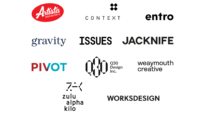
Edmund Li RGD, Associate and Design Director at Entro, shares his collection of three-dimensional letter forms.
What do you collect?
The stereotype of the typography-obsessed graphic designer is true of me. I am a type collector; I collect three-dimensional letterforms.
If you count everything I own, I have at least 1,270 individual letters currently in my possession. They range from the smallest movable type no bigger than six points to huge channel letters that are over half a metre tall. There is plenty of variety, including cut lettering of various materials ranging from medium density fiberboard (MDF), wood and acrylic to metal, cast letter, ceramic letters, metal channel letters, metal movable type (mostly kanji characters), woodblock letters, pin mounted letters, stone engraving, punch lettering sets, rubber stamp sets and handcrafted letterforms. There are probably more if I start looking around the house.
Until last year, these letters were kept in boxes and drawers. Now I display a selection of them in a multi-compartment clear acrylic display along with other small items my family has collected.

Since when?
The first few woodblock letters were given to me as a gift by Michael Peters, my mentor and art director from my first design job. I’m a passive collector—I didn’t plan special trips to the flea market searching for movable type or letters from vintage signs. As a designer working on exhibit and wayfinding projects throughout my career, project-specific samples were often submitted by fabricators for approval. When the projects are completed and storage space becomes limited, these items often end up on my desk.
People also began to bring me more dimensional letters after learning that I liked them. I recall a co-worker bringing me a couple of rare ceramic pin letters from the University of Pennsylvania after they returned from a work-related trip. I had never seen cast ceramic letterings with embedded pins, so I was fascinated. The fact that they spelled my initials made them extra-special. Gifts such as this one add a touch of warmth to my collection. Over time, by chance or on purpose, my collection of dimensional letters just expanded.

How does it inspire you as a designer?
I think designers love three-dimensional letters because we have a connection to typography. Three-dimensional letterforms, unlike printed type, are tangible and touchable. The tactile quality makes them real and strengthens our connection to design. The project-related letters remind me of the struggles and accomplishments along the course of a project. Movable type, woodblock lettering and other print-related letters connect us to the history of printing. At a time when almost everything is digital, this physicality helps to ground my connection to design.

Your favourites?
If I had to pick one favourite item from the collection, I would choose the oversized channel letters. These vintage letters used to be part of an exterior sign on the office building I worked in many years ago. The building has since been demolished and replaced by a condo. The letters remind me of all the experiences I had when I was working there, and I can use them to spell my last name and my initials. I still use the “E” for my profile picture in Zoom meetings.
An item you aspire to have in your collection?
My dream item would be the entire set of movable kanji characters (well over 50,000). But if this dream is realized, I don’t know where I would put them all. So far I have about 560 characters. Maybe it would be enough to have a Chinese/Japanese typewriter so I can use the letters I have already collected...

Another item I would love to have is one of the neon signs that used to fill the Hong Kong cityscape in the '80s. A very specific script type was typically used to form the letters on neon signs back then. These iconic neon letters are now rare, as preservation is not valued by the local government.
Edmund Li RGD
Edmund Li RGD is a creative director with over 25 years of experience designing interpretive and wayfinding signage, exhibits, donor recognition, and interactive around the world. Creating experiences that are accessible to all is an important aspect of his design philosophy. This is reflected in the choice of type, colour, contrast, and message delivery techniques in his projects. Edmund is a co-author of AccessAbility 2: A Practical Handbook on Accessible Graphic Design.
















